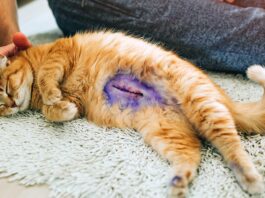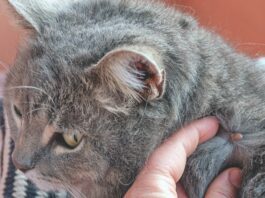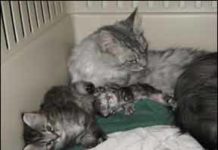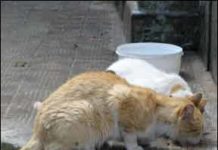Pyometra: A Deadly Threat
Humane considerations overwhelmingly support the practice of spaying — the surgical removal of a female cat’s ovaries and uterus — when an animal is about six months of age. Perhaps the most compelling argument in favor of this procedure (also known as ovariohysterectomy) is the reduction of feline overpopulation. One study has found that 85 percent of cats that are dropped off at shelters are eventually destroyed. It is estimated that as many as three to four million unwanted cats and kittens are put to sleep annually in the U.S.
Enjoying Hazard-Free Holidays
The holiday season is fast approaching, and your cat’s safety is probably the last thing on your mind — well behind preparing Thanksgiving dinner for your new in-laws and buying presents for Christmas or Chanukah. But it shouldn’t be. Probably the most important “gift” you can give your feline friend during these holidays is the pledge to remain alert about her whereabouts and well-being when your home is filled with guests, enticing foods, gift-wrapped goodies and new plants.
Ask Elizabeth: November 2011
Dear Elizabeth: Our seven-year-old female cat Queenie is a spayed, well-behaved Siamese who is never allowed outside. However, there are several free-roaming outdoor cats in the neighborhood, and they have become a real nuisance. About six months ago, my husband and I started smelling evidence that the front of our house and our doors were being scent-marked. The odor of urine is quite noticeable and unpleasant for us and also seems to agitate Queenie. We’ve thought about putting some sort of repellent outside, but we don’t want to use anything that could harm these neighborhood cats or wildlife. Do you have any recommendations? What can we do to stop — or at least discourage — these cats from scent-marking our house?
Short Takes: November 2011
Fish and flaxseed oil are excellent sources of n-3 polyunsaturated fatty acids (PUFA), and both have become popular dietary supplements. These fatty acids can modulate the immune response, and have been used to address canine skin conditions. However, the effects in cats have been relatively unknown. This study (“Dietary fish oil and flaxseed oil suppress inflammation and immunity in cats,” Veterinary Immunology and Immunopathology, 2011) investigates the responses in cats to fish or flaxseed oil.
Ways You Can Combat Feline Cancer
An estimated two percent of the 80 million or more cats now living in the United States will at some point develop cancer, a disease marked by the uncontrolled proliferation of cells on or within an animal’s hard and soft body tissues. Thanks to dramatic advances in veterinary medicine, many types of feline cancer are manageable — sometimes even reversible — if the condition is recognized early in its development and the affected cat is treated promptly and appropriately. But any cancer that remains undetected and untreated until it has reached an advanced stage is very likely to prove fatal.
Short Takes: October 2011
Cytauxzoonosis — often a fatal infection in domestic cats — is a disease caused by the parasite Cytauxzoon felis, which is transmitted by the bite of a tick. Most affected cats are young adults with exposure to the outdoors and vague clinical signs of lethargy and anorexia. Treatment for cytauxzoonosis is usually imidocarb diproprionate, but a combination of atovaquone and azithromycin (A&A) has also been utilized as a treatment. (neither form of therapy has been prospectively evaluated for efficacy, however). Eighty acutely ill cats with Cytauxzoon felis infection were treated at various veterinary clinics. Of 53 cats treated with A&A, 32 (60 percent) survived to discharge.
Maladies of the Feline Ear
While most cats will go through life without experiencing a serious problem with their ears, owners should know that a variety of conditions — including congenital defects, infections, trauma, and age-related changes — can be extremely painful and may compromise an animal’s hearing. Most feline ear disorders are readily treatable and will not result in permanent hearing loss, notes James Flanders, DVM, an associate professor of surgery at Cornell University’s College of Veterinary Medicine. However, some conditions may render a cat partially or totally deaf, especially if they remain unrecognized and untreated.
Ringworm: Very Contagious
Feline dermatophytosis, commonly referred to as ringworm, is a fungal infection that is frequently observed in cats. The condition occurs worldwide, most commonly in warm, humid climates that are hospitable to the peculiar type of fungus that causes it. In the U.S., the disorder is especially problematic year-round in the deep South, says William Miller, VMD, a professor of dermatology at Cornell University’s College of Veterinary Medicine, and its prevalence can rise markedly in cooler areas of the nation with the arrival of hot and muggy summer weather. The clinical signs of ringworm include areas of hair loss, broken and stubbly hair, patches of scaling, crusty or inflamed skin and alterations in hair color.
Ask Elizabeth: October 2011
Our 11-year-old cat, Abby, is recovering nicely from a recent bout of cystitis. As part of her recovery, our veterinarian recommended that she be encouraged to take in more liquids. At his suggestion, we now place clean water bowls on every floor of our house — and Abby drinks from all of them throughout the day. The veterinarian also suggested that we add some chicken broth to her canned and dry food to make it more appealing. So I got into the habit of preparing a nice kettle of clear broth, which I then freeze in an ice cube tray.
Rats! Good News for a Hardy Parasite
A common single-celled organism called Toxoplasma gondii is a parasite that infects many animals, including rats — in which it causes a peculiar and unexpected transformation. We all know that the average rat will avoid cats at all costs, and they become particularly nervous when exposed to cat urine. That is, unless they’re infected with Toxoplasma.
Understanding Feline Diabetes
A cat’s physical well-being depends largely on the efficiency of its endocrine system, an array of small organs that manufacture chemicals called hormones and deliver them into the animal’s bloodstream. Once they reach their respective target destinations, hormones interact with tissues to enable bodily processes and to ensure their effectiveness. Among the components of the endocrine system is the pancreas — a relatively tiny organ located near a cat’s stomach and small intestine. Perhaps the most important function of the pancreas is the manufacture of a hormone called insulin. After a cat has consumed fats, carbohydrates, and proteins, these dietary components are broken down into a vitally necessary chemical substance called glucose — sometimes referred to as “blood sugar.”
Hairballs: Sometimes Serious
Every so often, your otherwise fastidious cat will do this alarming and somewhat disgusting thing. She’ll awake from a peaceful nap, rise up on her paws, retch convulsively for a moment or two, and spit up what may appear at first glance to be a damp clump. What the animal has disgorged — in the middle of your kitchen floor or, worse yet, in the middle of your prized Persian rug — is a trichobezoar, a wad of undigested hair that is commonly referred to as a hairball.Despite the term, disgorged hairballs are not always round. They are often slender and cylindrical, shaped more like a cigar or sausage than a ball.














